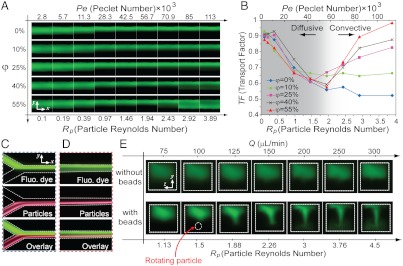Fig. 4.
Experimental evidence confirms particle-induced convection. (A) Fluorescent images obtained 2.5 cm downstream for increasing particle length fractions (φ), particle Reynolds number (Rp) and Peclet number (Pe). At low Pe diffusion is dominant. Due to the lower flow rate, dye has enough time to diffuse across the channel, thus full transfer is observed for all φ. For φ = 0%, diffusion is the only mechanism present, therefore increasing flow rate decreases the transfer. However, for higher φ as the flow rate increases, inertial effects start to become important, causing particle-induced disturbance flows that result in a net lateral transport. (B) Transport factor measured from these experimental conditions confirms the presence of transverse stirring of the fluid at high flow rates when particles are present. Also, an increase in transport factor is observed with increasing length fraction. (C, D) Fluorescence images of both fluid and particle streams at the inlet (C) and 2.5 cm downstream (D). Particles remain focused in their equilibrium position whereas the fluid is laterally transferred. (E) Confocal images confirm the recirculating secondary flow induced by the particles. Without 10 μm beads, the fluorescent stream occupies only half of the channel at high flow rates. However, when beads are present, fluid in the center of the channel is shown to be dragged towards the particle while circulating away at the top and bottom of the channel (note that confocal images are 90° rotated).

